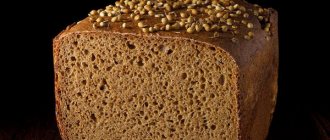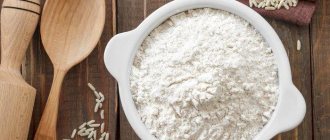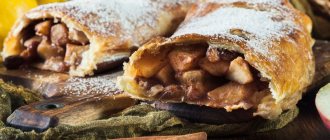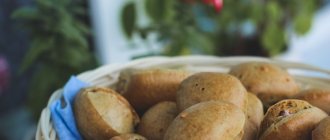Properties of Borodino bread
Nutritional value and composition | Vitamins | Minerals
How much does Borodino bread cost (average price for 1 piece)?
Moscow and Moscow region.
30 rub.
Borodino bread can rightfully be considered one of the most popular food products, which is in stable demand not only among the majority of residents of the Russian Federation, but also in countries that were formerly part of the USSR. We think there is no Russian person who has not tried Borodino rye bread at least once in his life. A distinctive feature of Borodino bread can be considered a sprinkling of coriander or cumin, which gives the finished baked product a characteristic taste and aroma.
In accordance with the classic recipe, Borodinsky bread contains wheat and rye flour, as well as rye malt, yeast, molasses, sugar, coriander, or in some versions, cumin is used as a topping. There are several versions of the origin of the Borodino bread recipe. One of the versions is connected with the War of 1812 and the site of a major battle on the Borodino field. Perhaps Borodino bread got its name in honor of the place where the recipe for the baked product was invented.
This happened in the Spaso-Borodinsky Monastery, which was built with her own money by Margarita Naryshkina, the wife of the famous general Alexander Tuchkov, who died in the Battle of Borodino. Legend has it that Mother Superior Maria, together with the nuns, baked funeral black Borodino bread in memory of her heroically deceased husband and other soldiers. The nuns baked the first Borodino bread from rye flour with the addition of malt and caraway seeds, as well as with the obligatory reading of prayer. However, in our time, the composition of Borodino bread, as well as the product itself, have undergone significant changes.
Calorie content of Borodinsky bread. Chemical composition and nutritional value.
Nutritional value and chemical composition of “Borodinsky Bread”.
The table shows the nutritional content (calories, proteins, fats, carbohydrates, vitamins and minerals) per 100 grams of edible portion.
| Nutrient | Quantity | Norm** | % of the norm in 100 g | % of the norm in 100 kcal | 100% normal |
| Calorie content | 201 kcal | 1684 kcal | 11.9% | 5.9% | 838 g |
| Squirrels | 6.8 g | 76 g | 8.9% | 4.4% | 1118 g |
| Fats | 1.3 g | 56 g | 2.3% | 1.1% | 4308 g |
| Carbohydrates | 39.8 g | 219 g | 18.2% | 9.1% | 550 g |
| Alimentary fiber | 5.8 g | 20 g | 29% | 14.4% | 345 g |
| Water | 37.3 g | 2273 g | 1.6% | 0.8% | 6094 g |
| Ash | 2.5 g | ~ | |||
| Vitamins | |||||
| beta carotene | 0.004 mg | 5 mg | 0.1% | 125000 g | |
| beta Cryptoxanthin | 1 mcg | ~ | |||
| Lutein + Zeaxanthin | 54 mcg | ~ | |||
| Vitamin B1, thiamine | 0.434 mg | 1.5 mg | 28.9% | 14.4% | 346 g |
| Vitamin B2, riboflavin | 0.335 mg | 1.8 mg | 18.6% | 9.3% | 537 g |
| Vitamin B4, choline | 14.6 mg | 500 mg | 2.9% | 1.4% | 3425 g |
| Vitamin B5, pantothenic | 0.44 mg | 5 mg | 8.8% | 4.4% | 1136 g |
| Vitamin B6, pyridoxine | 0.075 mg | 2 mg | 3.8% | 1.9% | 2667 g |
| Vitamin B9, folates | 151 mcg | 400 mcg | 37.8% | 18.8% | 265 g |
| Vitamin C, ascorbic acid | 0.4 mg | 90 mg | 0.4% | 0.2% | 22500 g |
| Vitamin E, alpha tocopherol, TE | 0.33 mg | 15 mg | 2.2% | 1.1% | 4545 g |
| Vitamin K, phylloquinone | 1.2 mcg | 120 mcg | 1% | 0.5% | 10000 g |
| Vitamin RR, NE | 3.805 mg | 20 mg | 19% | 9.5% | 526 g |
| Macronutrients | |||||
| Potassium, K | 166 mg | 2500 mg | 6.6% | 3.3% | 1506 g |
| Calcium, Ca | 73 mg | 1000 mg | 7.3% | 3.6% | 1370 g |
| Magnesium, Mg | 40 mg | 400 mg | 10% | 5% | 1000 g |
| Sodium, Na | 603 mg | 1300 mg | 46.4% | 23.1% | 216 g |
| Phosphorus, Ph | 125 mg | 800 mg | 15.6% | 7.8% | 640 g |
| Microelements | |||||
| Iron, Fe | 2.83 mg | 18 mg | 15.7% | 7.8% | 636 g |
| Manganese, Mn | 0.824 mg | 2 mg | 41.2% | 20.5% | 243 g |
| Copper, Cu | 186 mcg | 1000 mcg | 18.6% | 9.3% | 538 g |
| Selenium, Se | 30.9 mcg | 55 mcg | 56.2% | 28% | 178 g |
| Fluorine, F | 51 mcg | 4000 mcg | 1.3% | 0.6% | 7843 g |
| Zinc, Zn | 1.14 mg | 12 mg | 9.5% | 4.7% | 1053 g |
| Digestible carbohydrates | |||||
| Mono- and disaccharides (sugars) | 3.85 g | max 100 g | |||
| Essential amino acids | |||||
| Arginine* | 0.325 g | ~ | |||
| Valin | 0.379 g | ~ | |||
| Histidine* | 0.182 g | ~ | |||
| Isoleucine | 0.319 g | ~ | |||
| Leucine | 0.579 g | ~ | |||
| Lysine | 0.233 g | ~ | |||
| Methionine | 0.139 g | ~ | |||
| Threonine | 0.255 g | ~ | |||
| Tryptophan | 0.096 g | ~ | |||
| Phenylalanine | 0.411 g | ~ | |||
| Nonessential amino acids | |||||
| Alanin | 0.299 g | ~ | |||
| Aspartic acid | 0.442 g | ~ | |||
| Glycine | 0.302 g | ~ | |||
| Glutamic acid | 2.603 g | ~ | |||
| Proline | 0.909 g | ~ | |||
| Serin | 0.417 g | ~ | |||
| Tyrosine | 0.213 g | ~ | |||
| Cysteine | 0.173 g | ~ | |||
| Saturated fatty acids | |||||
| Saturated fatty acids | 0.626 g | max 18.7 g | |||
| 14:0 Miristinovaya | 0.011 g | ~ | |||
| 16:0 Palmitinaya | 0.385 g | ~ | |||
| 18:0 Stearic | 0.23 g | ~ | |||
| Monounsaturated fatty acids | 1.311 g | min 16.8 g | 7.8% | 3.9% | |
| 16:1 Palmitoleic | 0.012 g | ~ | |||
| 18:1 Oleic (omega-9) | 1.296 g | ~ | |||
| 20:1 Gadoleic (omega-9) | 0.003 g | ~ | |||
| Polyunsaturated fatty acids | 0.799 g | from 11.2 to 20.6 g | 7.1% | 3.5% | |
| 18:2 Linolevaya | 0.739 g | ~ | |||
| 18:3 Linolenic | 0.06 g | ~ | |||
| Omega-3 fatty acids | 0.06 g | from 0.9 to 3.7 g | 6.7% | 3.3% | |
| Omega-6 fatty acids | 0.739 g | from 4.7 to 16.8 g | 15.7% | 7.8% |
The energy value of Borodinsky bread is 201 kcal.
Primary Source: Created in the application by the user. Read more.
** This table shows the average levels of vitamins and minerals for an adult. If you want to know the norms taking into account your gender, age and other factors, then use the “My Healthy Diet” application.
Composition of Borodino bread
We think not many people know that the composition of the so beloved rye black bread contains only 15% rye flour. Many believe that the calorie content of Borodino bread is much lower than that of other varieties of the product. It is worth noting that the average calorie content of Borodino bread corresponds to 207 Kcal, which is per 100 grams of baked goods. For comparison, we present the caloric content of white bread made only from wheat flour - 259 Kcal.
The thing is that for the last 40 years Borodino bread has been made from second-grade wheat flour with the addition of rye flour. True, in fairness it is worth noting that in reality there is a clear benefit of Borodino bread for the human body. Before the benefits of Borodino bread become obvious, you just need to look at the composition of the bakery product, which contains not only PP and B vitamins, but also such useful compounds as iron, magnesium, sodium, calcium, phosphorus and potassium.
Harm to the body
Frequent consumption of baked goods in large quantities can lead to digestive problems - sour sourdough and spices (coriander) irritate the mucous membrane of the stomach and intestines, leading to the development of dyspeptic symptoms (stomach pain, flatulence, bloating). Constipation may develop.
Persons with gastrointestinal diseases should limit the consumption of rye baked goods, especially fresh ones. In case of exacerbation of ulcers and chronic gastritis, it is completely excluded from the diet.
Those suffering from gluten intolerance (celiac disease) and food allergies to gluten should avoid eating rye bread, or consume it in minimal quantities as directed by a doctor. It also turns out to be not entirely useful for people who are concerned about losing weight if they overindulge in eating bread.
Which one can you eat?
There are many types of bread. Each has its own advantages. It is difficult to immediately and unequivocally answer which is the most useful.
Black or white
These are the most common varieties. Both types are baked from cereals, but rye is used for black bread, and wheat is used for white bread. Some time ago, the first one was more popular, because this crop is less demanding and grows well in the northern regions. White bread was rare for a long time.
In terms of calories and carbohydrates, both varieties are almost the same. 100 grams of white contain approximately 230 - 240 kcal, and black - about 200 kcal. Also, there are almost 40 carbohydrates in both varieties. The main difference is the size of the glycemic index.
White bread greatly increases your appetite. After a short time, the person wants to eat again. Therefore, for dietary nutrition you need to give up sliced loaves, baguettes, buns and other things.
For baking, refined premium-grade wheat flour is used, which is inversely proportional to its usefulness. It contains fast carbohydrates that immediately break down glucose. It does not have time to be consumed and begins to accumulate in problem areas, and the person feels hungry and eats again.
Therefore, from this point of view, black will be more useful. But you don’t have to give up white completely. To do this, you can choose products made from wholemeal flour, and also have additives in the form of flax seeds, pumpkin seeds, sunflower seeds, and oatmeal.
You can also find black on store shelves, which has similar characteristics.
To find out which bread is healthier - black or white, watch this video:
Rye
This type of bread is also called gray. In terms of calories and carbohydrates, it is not much different from white and black. But its glycemic index is the lowest. In addition, it contains a lot of lysine. This is an amino acid that is very important for the normal functioning of body systems. The best choice for a diet would be rye bread. They can be eaten in different ways.
But there is a contraindication in eating gray bread for people with high stomach acidity, since lactic acid bacteria are used in its production. Therefore, it has a slightly specific taste. It is best to replace it with bread made from mixed flour - rye and wheat; it will be less “aggressive”.
Borodinsky
Its properties are very similar to products made from white flour. But Borodinsky has an admixture of rye, and the second grade of wheat is used, and it is also sprinkled with caraway seeds, coriander, and anise. They contain useful substances. Therefore, a piece of Borodino bread can be eaten in the first half of the day, in combination with something low-calorie.
Yeast-free
Some people believe that consuming these species is much healthier. But it is not so. It's not much better in terms of calories. But its main advantage is that yeast is not used when baking. And these are fungi that, when the immune system is weakened by diseases, taking antibiotics, or regular stress, can cause various ailments that are difficult to treat. And also increase acidity in the stomach.
Therefore, you can temporarily switch to yeast-free, but it will not become a panacea for gaining excess weight if you use it without knowing the limits.
With bran
This type of bread contains a lot of nicotinic acid. It prevents the development of diseases of the gastrointestinal tract and prevents atherosclerosis. In addition, bran products are rich in fiber, proteins, and vitamins. All this helps strengthen the immune system, improve intestinal function, and promote muscle growth.
With buckwheat flour
You can rarely find this type of product in stores, but it’s worth a try. It contains a lot of vitamins and minerals, dietary fiber. In addition, bread made from buckwheat flour has nutritional properties. If you eat it with low-calorie dishes, the feeling of hunger will not appear soon.
How many calories are in 100 grams of Borodino bread?
Every 100 grams of Borodino bread without any additives has 208 calories. It has a sweetish spicy taste and goes very well with butter, cheese and honey. It can completely replace desserts on a diet.
Sourdough
Sourdough bread is considered less nutritious - its energy value is 178 calories per 100 grams. It is a little healthier than usual due to the special preparation technology, has a slightly sour taste and for most people born in the Soviet Union it resembles the bread of that time.
Other Supplements
Unfortunately, modern products often do not meet GOST requirements. In most cases, manufacturers use various additives to save money or for other purposes. If used in acceptable dosages, they will not cause harm to health. However, the taste will change somewhat.
The main types of additives that are used in the production of Borodino bread are:
- improvers
- make the finished product more porous, and also change its appearance for the better; - sugar color
– gives the product a brown tint; - brews
- made on the basis of red malt, the composition also includes coriander; - sourdoughs
- for kneading dough, ready-made rye sourdoughs are often used, to which malt is added.
Depending on the additives used, the color, taste and even calorie content of Borodino bread may change slightly.









